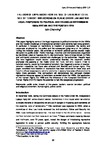'Freedom of Expression from the ‘Age of Extremes’ to the ‘Age of Terror’: Reflections on Public Order Law and the Legal Responses to Political and Religious Extremism in 1930s Britain and the Post 9/11
| dc.contributor.author | Channing, Ian | |
| dc.date.accessioned | 2017-03-20T16:51:33Z | |
| dc.date.accessioned | 2017-04-11T08:27:11Z | |
| dc.date.available | 2017-03-20T16:51:33Z | |
| dc.date.available | 2017-04-11T08:27:11Z | |
| dc.date.issued | 2011 | |
| dc.identifier.citation |
Channing, I. (2011) ''Freedom of Expression from the ‘Age of Extremes’ to the ‘Age of Terror’: Reflections on Public Order Law and the Legal Responses to Political and Religious Extremism in 1930s Britain and the Post 9/11', Law, Crime and History, 1(2), pp.32-57. Available at: https://pearl.plymouth.ac.uk/handle/10026.1/8863 | en_US |
| dc.identifier.issn | 2045-9238 | |
| dc.identifier.uri | http://hdl.handle.net/10026.1/8863 | |
| dc.description.abstract |
This paper highlights some of the legal responses to political extremism in the 1930s and the modern challenge of international terrorism and extreme right-wing activism. In particular, it focuses on restrictions to freedom of expression, the tactics and responses employed by the police and the subsequent judgments of the judiciary. During the interwar years, the activities of extremist political parties caused major disruption to public order. Public meetings, marches and demonstrations organised by the British Union of Fascists (BUF), the Communist Party of Great Britain (CPGB) and anti-fascist protestors created new challenges for the authorities. Despite fears that new legislation would restrict fundamental liberties, the recurrent conflict prompted the passing of the Public Order Act 1936. Similarly, today's threat to national security, posed by international terrorism, has triggered a series of counterterrorism measures that have also affected civil liberties and human rights. This paper considers how freedom of expression has been restricted in these eras and how the official responses to extreme elements in society have also affected citizen's rights more generally. This comparison will demonstrate that although modern repressive measures appear to have been extended since the 1930s, the application of the Human Rights Act 1998 and the influence of the European Convention of Human Rights (ECHR) inspire the potential to halt this dangerous progression. | en_US |
| dc.language.iso | en | en_US |
| dc.publisher | University of Plymouth | |
| dc.rights | Attribution 4.0 International (CC BY 4.0) | * |
| dc.rights.uri | https://creativecommons.org/licenses/by/4.0/ | * |
| dc.subject | public order | en_US |
| dc.subject | breach of the peace | en_US |
| dc.subject | fascism | en_US |
| dc.subject | counter terrorism | en_US |
| dc.subject | political and religious extremism | en_US |
| dc.subject | human rights | en_US |
| dc.subject | police tactics | en_US |
| dc.title | 'Freedom of Expression from the ‘Age of Extremes’ to the ‘Age of Terror’: Reflections on Public Order Law and the Legal Responses to Political and Religious Extremism in 1930s Britain and the Post 9/11 | en_US |
| dc.type | Article | en_US |
| dc.type | Article | |
| plymouth.issue | 2 | |
| plymouth.volume | 1 | |
| plymouth.journal | SOLON Law, Crime and History |



